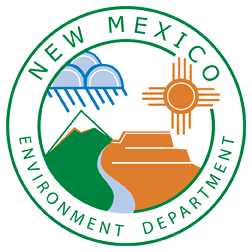The Hydrology Protocol provides a methodology for distinguishing among ephemeral, intermittent and perennial streams and rivers in New Mexico. The protocol and process for using the protocol is found in the State of New Mexico’s Water Quality Management Plan and Continuing Planning Process (WQMP/CPP).
For further information, contact Michael Baca, Water Quality Standards Coordinator.
Who Can Conduct the Hydrology Protocol
Anyone may use the Hydrology Protocol as part of a Use Attainability Analysis (UAA) to change a designated use based on the hydrologic regime of the waterbody using the established guidance in the Department’s WQMP/CPP.
Because the Hydrology Protocol was intended to provide the technical supporting data of a UAA, and cannot be used in place of a UAA, entities outside of the Department intending to conduct a UAA using the Hydrology Protocol must submit a work plan to the Department and EPA Region 6 in accordance with 20.6.4.15.D NMAC. This workplan must be approved by the Department prior to beginning any investigation. For further information on the UAA process, please refer to the Department’s WQMP/CPP and SWQB’s UAA webpage.
What UAAs using the Hydrology Protocol Have Been Completed
The following is a list of UAAs that used the Hydrology Protocol. Note, this list identifies all investigations including those that did not lead to a rulemaking process.
| Waterbody | Basin | Final Action* |
| San Isidro Arroyo and Tributaries | Rio Grande | 2019 UAA |
| Santa Fe River | Rio Grande | |
| Cunningham gulch | Rio Grande | 2013 TR |
| Tributary to Arroyo Hondo | Rio Grande | 2013 TR |
| Tributary to San Pedro Creek | Rio Grande | 2013 TR |
| Inditos Draw | Rio Grande | 2013 TR |
| Unnamed Tributary upstream of NM Firefighters Academy Outfall | Rio Grande | 2013 TR |
| Unnamed Tributary to Rio Grande Flood Control South Channel | Rio Grande | 2013 TR |
| Canon del Piojo | Rio Grande | 2013 TR |
| Tributary to Canon del Piojo | Rio Grande | 2013 TR |
| Arroyo del Puerto | Rio Grande | 2013 TR |
| Tributary to San Mateo Creek | Rio Grande | 2013 TR |
| San Isidro Arroyo | Rio Grande | |
| Tinaja Arroyo | Rio Grande | |
| Mulatto Canyon | Rio Grande | 2013 TR |
| Tributary to Hart Canyon | Pecos | 2013 TR |
| Agua Chiquita | Pecos | |
| Grindstone Canyon | Pecos | |
| Bracket Canyon | Pecos | 2013 TR |
| Tributary to Bracket Canyon | Pecos | 2013 TR |
| Gachupin Canyon | Pecos | 2013 TR |
| Tributary to Kim-me-ni-oli wash | San Juan | 2013 TR |
| Defiance Draw | Little Colorado | 2013 TR |
| Tributary to Defiance Draw | Little Colorado | 2013 TR |
| San Andres Canyon | Tularosa** | |
| San Vicente Arroyo | Mimbres** | |
*”TR”-Triennial Review, “NA” No Action, “IP” In Progress, “UAA” Use Attainability Analysis independent of the Triennial Review Process
**Closed Basin
Are There Different Processes to Approve a Hydrology Protocol UAA
In most cases, the process is the same as for any UAA. However, for a Hydrology Protocol UAA conducted by the Department to which there is no substantial public interest, an alternative UAA process may be used for UAAs conducted by the Department using the Hydrology Protocol. This alternative process is outlined under 20.6.4.15.C NMAC and was developed to facilitate the efficient application of the limited aquatic life and secondary contact uses to ephemeral waters. This process allows for implementation of the new designated uses for Clean Water Act purposes prior to completion of the required hearing before the WQCC and rulemaking process. For more information regarding the UAA process please refer to the Department’s WQMP/CPP.
The History of the Hydrology Protocol
The Federal Clean Water Act (CWA) Section 101(a)(2) requires wherever attainable, water quality which provides for the protection and propagation of fish, shellfish, and wildlife and provides for recreation in and on the water. This shall be done in order to restore and maintain the chemical, physical and biological integrity of the Nation’s waters. Under the auspice of the rebuttable presumption, EPA has asserted that these protections are applicable to all surface waters, unless demonstrated otherwise.
In response to a long-standing EPA concern that all waters, not only classified waters, must be protected by New Mexico’s water quality standards (WQS), the WQS were amended in 2005 to establish separate provisions and designated uses for three (3) hydrological regimes of unclassified waters (ephemeral, intermittent and perennial). These provisions afforded protections outlined under the CWA Section 101(a)(2). Although protections were established, the process to evaluate and apply the designated uses to specific waterbodies was still needed.
The new or revised water quality standard is required to be based on the highest attainable use. For unclassified perennial waterbodies, this would be the designated uses identified under 20.6.4.99 NMAC. For unclassified non-perennial waterbodies, the most protective uses are those identified under 20.6.4.98 NMAC for intermittent waterbodies.
It is known that many of New Mexico’s waterbodies are naturally ephemeral, and in accordance with 40 CFR 131.10(g)(2) a designated use may be changed if the natural, ephemeral, intermittent or low-flow conditions are preventing attainment of the use; However, this can only be done through a UAA in accordance with 40 CFR 131.10(j), if either
- a CWA Section 101(a)(2) designated use is established for the first time; or
- the CWA Section 101(a)(2) designated use (or a sub-category of a use) is being removed; or
- the CWA Section 101(a)(2) subcategory is being changed to a use that is less stringent than the previously applicable use. due to the natural, ephemeral, intermittent or low flow conditions or water levels preventing the attainment of the use as described as one of six (6) elements under 40 CFR 131.10(g)(1)-(6).
The Hydrology Protocol was drafted to support the UAA process for establishing the highest attainable uses for a waterbody given its natural hydrologic regime. The draft Hydrology Protocol underwent public comment in 2009 and a subsequent public comment period in early 2011 before it was approved on May 10, 2011 by the Water Quality Control Commission (WQCC), as an Appendix to the WQMP/CPP. It was submitted to the EPA for review and approved on December 23, 2011 and now serves as the primary technical support method for designated use changes based solely on hydrologic regime.

